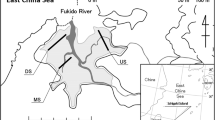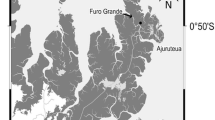Abstract
Ecological functions of bioturbation in ecosystems have received increasing attention over the recent decades, and crab burrowing has been considered as one of the major bioturbations affecting the physical and chemical processes in salt marshes. This study assessed the integrated effects of crab excavating and burrow mimic trapping on sediment turnover and vertical C and N distributions in a Chinese salt marsh in the Yangtze River estuary. Crab burrowing increased soil water content and the turnover of carbon and nitrogen and decreased bulk soil density. Vertical movement of materials, nutrient cycling and reuse driven by crab burrowing might be obstructed by vegetation (Phragmites australis and Spartina alterniflora communities). The amount of soil excavated by crab burrowing was higher than that deposited into burrow mimics. In Phragmites marshes, Spartina marshes and unvegetated mudflats, net transport of soil to the marsh surface was 171.73, 109.54, and 374.95 g m−2 d−1, respectively; and the corresponding estimated soil turnover time was 2.89, 4.07 and 1.83 years, respectively. Crab burrowing in salt marshes can mix surface and deeper soil over a period of years, accelerating litter decomposition and promoting the efficient reuse of nutrients by plants. Therefore, bioturbation affects soil physical processes and functioning of ecosystems, and needs to be addressed in ecosystem management.







Similar content being viewed by others
References
Bertics VJ, Ziebis W. 2009. Biodiversity of benthic microbial communities in bioturbated coastal sediments is controlled by geochemical microniches. ISME J 3:1269–85.
Bertness MD. 1985. Fiddler crab regulation of Spartina alterniflora production on a New England salt marsh. Ecology 66:1042–55.
Bortolus A, Iribarne O. 1999. Effects of the SW atlantic burrowing crab Chasmagnathus granulata on a Spartina salt marsh. Mar Ecol Prog Ser 178:79–88.
Botto F, Iribarne O. 2000. Contrasting effects of two burrowing crabs (chasmagnathus granulata and Uca uruguayensis) on sediment composition and transport in estuarine environments. Estuar Coast Shelf Sci 51:141–51.
Botto F, Iribarne O, Gutierrez J, Bava J, Gagliardini A, Valiela I. 2006. Ecological importance of passive deposition of organic matter into burrows of the SW Atlantic crab Chasmagnathus granulatus. Mar Ecol Prog Ser 312:201–10.
Botto F, Valiela I, Iribarne O, Martinetto P, Alberti J. 2005. Impact of burrowing crabs on N and N sources, control, and transformations in sediments and food webs of SW Atlantic estuaries. Mar Ecol Prog Ser 293:155–64.
Canepuccia AD, Fanjul MS, Fanjul E, Botto F, Iribarne O. 2008. The intertidal burrowing crab Neohelice (= Chasmagnathus) granulata positively affects foraging of rodents in south western atlantic salt marshes. Estuar Coasts 31:920–30.
Chen HL, Li B, Fang CM, Chen JK, Wu JH. 2007. Exotic plant influences soil nematode communities through litter input. Soil Biol Biochem 39:1782–93.
Costanza R, dArge R, deGroot R, Farber S, Grasso M, Hannon B, Limburg K, Naeem S, Oneill RV, Paruelo J, Raskin RG, Sutton P, vandenBelt M. 1997. The value of the world’s ecosystem services and natural capital. Nature 387:253–60.
Daehler CC, Strong DR. 1996. Status, prediction and prevention of introduced cordgrass Spartina spp. invasions in pacific estuaries, USA. Biol Conserv 78:51–8.
Daleo P, Iribarne O. 2009. The burrowing crab Neohelice granulata affects the root strategies of the cordgrass Spartina densiflora in SW Atlantic salt marshes. J Exp Mar Biol Ecol 373:66–71.
Darwin C. 1881. The formation of vegetable mould through the action of worms with observation of their habits. London: John Murray.
Emmerson WD. 1994. Seasonal breeding cycles and sex-ratios of 8 species of crabs from Mgazana, a mangrove estuary in Transkei, southern Africa. J Crustac Biol 14:568–78.
Fanjul E, Grela MA, Canepuccia A, Iribarne O. 2008. The Southwest Atlantic intertidal burrowing crab Neohelice granulata modifies nutrient loads of phreatic waters entering coastal area. Estuar Coast Shelf Sci 79:300–6.
Fanjul E, Grela MA, Iribarne O. 2007. Effects of the dominant SW Atlantic intertidal burrowing crab Chasmagnathus granulatus on sediment chemistry and nutrient distribution. Mar Ecol Prog Ser 341:177–90.
Gribsholt B, Kostka JE, Kristensen E. 2003. Impact of fiddler crabs and plant roots on sediment biogeochemistry in a Georgia saltmarsh. Mar Ecol Prog Ser 259:237–51.
Gutierrez JL, Jones CG, Groffman PM, Findlay SEG, Iribarne OO, Ribeiro PD, Bruschetti CM. 2006. The contribution of crab burrow excavation to carbon availability in surficial salt-marsh sediments. Ecosystems 9:647–58.
Gyllström M, Lakowitz T, Brönmark C, Hansson LA. 2008. Bioturbation as driver of zooplankton recruitment, biodiversity and community composition in aquatic ecosystems. Ecosystems 11:1120–32.
Herringshaw LG, Solan M. 2008. Benthic bioturbation in the past, present and future. Aquat Biol 2:201–5.
Iribarne O, Bortolus A, Botto F. 1997. Between-habitat differences in burrow characteristics and trophic modes in the southwestern Atlantic burrowing crab Chasmagnathus granulata. Mar Ecol Prog Ser 155:137–45.
Karlson K, Bonsdorff E, Rosenberg R. 2007. The impact of benthic macrofauna for nutrient fluxes from Baltic Sea sediments. Ambio 36:161–7.
Katrak G, Dittmann S, Seuront L. 2008. Spatial variation in burrow morphology of the mud shore crab Helograpsus haswellianus (Brachyura, Grapsidae) in South Australian saltmarshes. Mar Freshw Res 59:902–11.
Katz LC. 1980. Effects of burrowing by the fiddler crab, Uca pugnax (Smith). Estuar Coast Mar Sci 11:233–7.
Lee SY. 1998. Ecological role of grapsid crabs in mangrove ecosystems: a review. Mar Freshw Res 49:335–43.
Li B, Liao CH, Zhang XD, Chen HL, Wang Q, Chen ZY, Gan XJ, Wu JH, Zhao B, Ma ZJ, Cheng XL, Jiang LF, Chen JK. 2009. Spartina alterniflora invasions in the Yangtze River estuary, China: an overview of current status and ecosystem effects. Ecol Eng 35:511–20.
Liu GS. 1996. Soil physical and chemical analysis description of soil profiles. Beijing: Standards Press of China.
McHenga ISS, Tsuchiya M. 2008. Nutrient dynamics in mangrove crab burrow sediments subjected to anthropogenic input. J Sea Res 59:103–13.
Mighter MS, Schaffner L, Kemp WM. 1995. Nitrification potentials of benthic macrofaunal tubes and burrow walls—effects of sediment nh4+ and animal irrigation behavior. Mar Ecol Prog Ser 121:157–69.
McCraith BJ, Gardner LR, Wethey DS, Moore WS. 2003. The effect of fiddler crab burrowing on sediment mixing and radionuclide profiles along a topographic gradient in a southeastern salt marsh. J Mar Res 61:359–90.
Meysman FJR, Middelburg JJ, Heip CHR. 2006. Bioturbation: a fresh look at Darwin’s last idea. Trends Ecol Evol 21:688–95.
Mitsch JW, Gosselink JG. 1993. Wetlands. New York: Van Nostrand Reinhold.
Montague CL. 1982. The influence of fiddler crab burrows and burrowing on metabolic processes in salt marsh sediments. In: Kennedy VS, Ed. Estuarine comparisons. New York: Academic Press. p 283–301.
Neira C, Grosholz ED, Levin LA, Blake R. 2006. Mechanisms generating modification of benthos following tidal flat invasion by a Spartina hybrid. Ecol Appl 16:1391–404.
Nielsen OI, Kristensen E, Macintosh DJ. 2003. Impact of fiddler crabs (Uca spp.) on rates and pathways of benthic mineralization in deposited mangrove shrimp pond waste. J Exp Mar Biol Ecol 289:59–81.
Odum EP. 1980. The status of three ecosystem level hypothesis regarding salt marsh estuaries: tidal, subsidy, outwelling and detritus-based food chains. In: Kennedy VS, Ed. Estuarine perspective. New York: Academic Press. p 485–95.
Otani S, Kozuki Y, Yamanaka R, Sasaoka H, Ishiyama T, Okitsu Y, Sakai H, Fujiki Y. 2010. The role of crabs (Macrophthalmus japonicus) burrows on organic carbon cycle in estuarine tidal flat, Japan. Estuar Coast Shelf Sci 86:434–40.
Paarlberg AJ, Knaapen MAF, de Vries MB, Hulscher S, Wang ZB. 2005. Biological influences on morphology and bed composition of an intertidal flat. Estuar Coast Shelf Sci 64:577–90.
Reinsel KA. 2004. Impact of fiddler crab foraging and tidal inundation on an intertidal sandflat: season-dependent effects in one tidal cycle. J Exp Mar Biol Ecol 313:1–17.
Smith NF, Wilcox C, Lessmann JM. 2009. Fiddler crab burrowing affects growth and production of the white mangrove (Laguncularia racemosa) in a restored Florida coastal marsh. Mar Biol 156:2255–66.
Sun SC, Cai YL, Liu H. 2001. Biomass allocation of Scirpus mariqueter along an elevational gradient in a salt marsh of the Yangtse River estuary. Acta Bot Sin 43:178–85.
Takeda S, Kurihara Y. 1987. The effects of burrowing of Helice tridens (Dehaan) on the soil of a salt marsh habitat. J Exp Mar Biol Ecol 113:79–89.
van Nugteren P, Herman PMJ, Moodley L, Middelburg JJ, Vos M, Heip CHR. 2009. Spatial distribution of detrital resources determines the outcome of competition between bacteria and a facultative detritivorous worm. Limnol Oceanogr 54:1413–19.
Wang JQ. 2008. Habitat selection and ecosystem engineering effects of dominant burrowing crabs in salt marshes in the Yangtze River estuary, China. Shanghai, China: Fudan University.
Wang JQ, Zhang XD, Nie M, Fu CZ, Chen JK, Li B. 2008. Exotic Spartina alterniflora provides compatible habitats for native estuarine crab Sesarma dehaani in the Yangtze River estuary. Ecol Eng 34:57–64.
Wang Q. 2007. The dynamics of plant community distribution of the salt marshes in the Yangtze River estuary as influenced by Spartina alterniflora invasions. Shanghai, China: Fudan University.
Warren JH, Underwood AJ. 1986. Effects of burrowing crabs on the topography of mangrove swamps in New South Wales. J Exp Mar Biol Ecol 102:223–35.
Webb AP, Eyre BD. 2004. The effect of natural populations of the burrowing and grazing soldier crab (Mictyris longicarpus) on sediment irrigation, benthic metabolism and nitrogen fluxes. J Exp Mar Biol Ecol 309:1–19.
Weissberger EJ, Coiro LL, Davey EW. 2009. Effects of hypoxia on animal burrow construction and consequent effects on sediment redox profiles. J Exp Mar Biol Ecol 371:60–7.
Wolfrath B. 1992. Burrowing of the fiddler crab Uca-tangeri in the Ria Formosa in Portugal and its influence on sediment structure. Mar Ecol Prog Ser 85:237–43.
Xu HF, Zhao YL. 2005. The report of scientific survey on the Chongming Dongtan Migratory Birds Reserve of Shanghai. Beijing: China Forestry Publishing House.
Acknowledgments
We thank Jun Cui for critically reading the early draft of this manuscript, Dr. Liang Jin (Lanzhou University, China) for facilitating the measurements of sediment grain size, and Dr. Michael Pace and two anonymous referees for their numerous valuable comments which greatly improved the quality of our manuscript. This study was financially supported by National Basic Research Program of China (Grant No. 2006CB403305), and National Science Foundation of China (Grant Nos. 30670330 and 30930019). BL received JSPS (Japan Society for the Promotion of Science) Invitation Fellowship (JSPS-S08102) when this manuscript was under preparation.
Author information
Authors and Affiliations
Corresponding author
Additional information
Author Contributions
J. Wang and X. Zhang are equal contributors. Conceived of study: JQW, CMF, JKC, TH, BL; performed research: JQW, XDZ, LFJ; analyzed data: JQW, XDZ; wrote the paper: JQW, XDZ, MDB, BL
Electronic supplementary material
Below is the link to the electronic supplementary material.
Rights and permissions
About this article
Cite this article
Wang, J.Q., Zhang, X.D., Jiang, L.F. et al. Bioturbation of Burrowing Crabs Promotes Sediment Turnover and Carbon and Nitrogen Movements in an Estuarine Salt Marsh. Ecosystems 13, 586–599 (2010). https://doi.org/10.1007/s10021-010-9342-5
Received:
Accepted:
Published:
Issue Date:
DOI: https://doi.org/10.1007/s10021-010-9342-5




